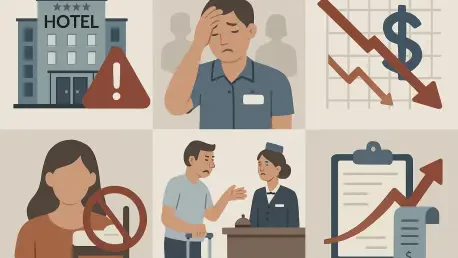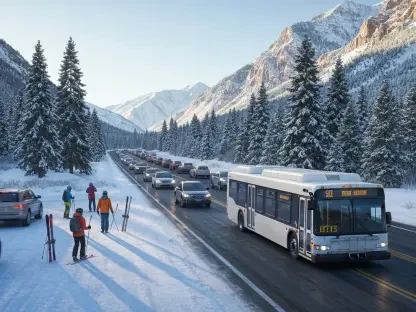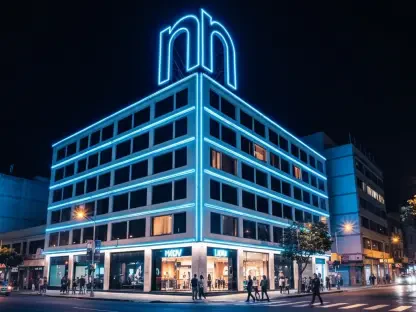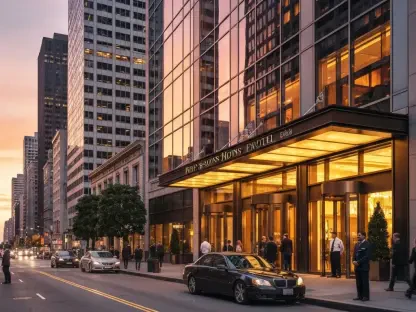I’m thrilled to sit down with Katarina Railko, a seasoned expert in the hospitality industry with a wealth of experience in travel and tourism. Katarina has honed her skills across various facets of the sector and is a prominent voice in entertainment and events, often sharing her insights at expos and conferences. Today, we’re diving into the current state of the U.S. hotel industry amidst a challenging economy, exploring trends in travel demand, rising operational costs, and the stark contrast between luxury and lower-tier segments. Let’s unpack what’s shaping the landscape and what hoteliers can expect in the coming years.
Can you give us a broad picture of how the U.S. hotel industry is performing right now, especially given the economic headwinds we’re facing?
Absolutely, Alex. The U.S. hotel industry is in a bit of a rough patch at the moment. We’re seeing a noticeable “stutter” in performance, with room demand declining for five straight months through August, and September isn’t looking much better. This comes on the heels of widespread RevPAR declines reported by major hotel companies in the second quarter. Economic uncertainty lingering into 2025 is definitely playing a role, alongside specific challenges like weaker business travel and a drop in international visitors. It’s a complex situation, and hoteliers are having to rethink their strategies to navigate this turbulence.
What do you think are the main drivers behind this consistent drop in hotel room demand over recent months?
There are a few key factors at play. First, business travel has taken a hit, which is a big revenue driver for many hotels. Companies are tightening budgets, and remote work continues to reduce the need for in-person meetings. Second, international inbound travel is down, particularly from markets like Canada, which has noticeably affected destinations like Las Vegas. Add to that a decline in government travel, which some hotel CEOs have flagged as a significant issue. It’s a mix of economic caution and shifting travel behaviors that’s creating this demand slump across various regions.
Speaking of international travel, what’s causing this specific decline in visitors, especially from Canada, and how are hoteliers in impacted areas responding?
The dip in international travel, particularly from Canada, seems to stem from a combination of economic pressures and possibly some policy-related hesitations. Globally, travelers are feeling the pinch of inflation, and currency fluctuations can make U.S. trips less affordable. There’s also been a noted trend of global travel buyers canceling U.S.-based meetings due to recent government actions, as reported by industry associations. In response, hoteliers in places like Las Vegas are pivoting to attract more domestic travelers or focusing on niche markets. Some are offering tailored packages or promotions to offset the loss, but it’s a tough gap to fill when international spending power is down.
I’ve heard that reduced government travel is also hurting RevPAR. Can you shed some light on why this is happening and how significant the impact is?
Yes, government travel cutbacks are definitely a factor. A lot of it ties back to tighter federal and state budgets, with agencies scaling back on conferences, training sessions, and other travel-related expenses. This is particularly impactful for hotels in areas near government hubs or those that rely on contracts for steady bookings. The effect on RevPAR is notable because government travel often fills rooms during off-peak times or in less tourist-heavy destinations. Without that consistent demand, hotels are seeing weaker overall performance metrics, compounding other economic challenges.
One striking trend is the incredibly short booking windows, with 40% of transient business in the U.S. booked in under four days. What’s driving this shift in traveler behavior?
This trend toward last-minute bookings is fascinating and reflects a broader change in how people plan travel. A big driver is the uncertainty many feel—whether it’s economic or just personal flexibility. Travelers are waiting until the last moment to commit, often looking for deals or ensuring their plans align with their schedules. The rise of mobile booking platforms also plays a role, making it easier to book on a whim. For hotels, though, this creates real challenges in forecasting and managing inventory, pushing them to adopt more dynamic pricing and real-time availability tools to capture these bookings.
Looking ahead, the RevPAR forecast for 2025 isn’t very optimistic, with a predicted 0.1% decrease year over year. What’s contributing to this gloomy outlook?
The negative RevPAR forecast for 2025 is tied to a few persistent issues. Demand isn’t expected to rebound quickly, with occupancy projected to dip to 62.5%. While average daily rates might inch up by 0.8%, it’s not enough to offset the lower occupancy. Analysts are also pointing to ongoing economic uncertainty and the slower recovery of key segments like business and international travel. There’s a cautious sentiment in the industry, and without a significant shift in consumer confidence or policy support, these numbers reflect a conservative, if not pessimistic, view of next year’s performance.
On top of revenue challenges, operating costs like labor and technology are climbing, with labor up 2.6% year over year. How are hotel owners managing these rising expenses?
Rising costs are a huge concern for hotel owners right now. Labor, which is up 2.6%, is a major line item, and technology costs have spiked even more, around 5%. Owners are getting creative—many are optimizing staffing levels, which means cross-training employees to handle multiple roles or leaning on automation for tasks like check-in. Some are also renegotiating vendor contracts to cut expenses. But there’s a fine line; cutting too much on staff or services can hurt guest experience, which risks long-term loyalty. It’s about finding balance while maintaining quality.
Insurance costs were also flagged as a significant burden. Can you explain why these costs are increasing so dramatically and the effect on profit margins?
Insurance costs are soaring due to a mix of factors. We’re seeing more frequent and severe natural disasters, which drive up property insurance premiums, especially in vulnerable areas. There’s also a broader trend of rising liability claims in the hospitality sector, pushing insurers to hike rates. For hoteliers, this is a direct hit to profit margins, especially when revenues are already under pressure. Some are having to absorb these costs, while others pass a portion to guests through higher rates or fees, but it’s a tough balancing act when demand is soft.
There’s a clear divide in the industry, with luxury hotels thriving while lower-tier segments struggle. What’s behind this disparity, and how is it shaping hotel strategies?
This bifurcation is really a tale of two markets. On one hand, luxury hotels are benefiting from a growing group of wealthy travelers, especially those over 55 who hold a significant chunk of U.S. financial wealth and love to travel. On the other hand, lower-tier segments cater to travelers earning under $75,000 annually, who are hit harder by inflation on basics like food and gas. This wealth gap means luxury hotels can maintain high rates and occupancy, while economy and midscale properties face steeper declines in gross operating profit—down 7.8% in some cases. Strategically, many hoteliers are focusing on capturing high-end demand or exploring resilient niches like extended stay, which continues to perform well even in lower tiers.
What’s your forecast for the U.S. hotel industry over the next couple of years, considering these economic and operational challenges?
Looking ahead to 2025 and 2026, I think the U.S. hotel industry will face a slow grind toward recovery. RevPAR and demand forecasts remain soft, with occupancy not expected to climb back above 63% until 2027. Economic uncertainty, paired with lingering issues like reduced business travel and high costs, will keep pressure on profit margins. However, segments like luxury and extended stay offer bright spots, and hotels that can adapt through technology and targeted marketing might carve out growth. A lot depends on broader economic trends—if consumer confidence or international travel rebounds faster than expected, we could see an earlier uptick, but I’m cautiously optimistic at best for the near term.









